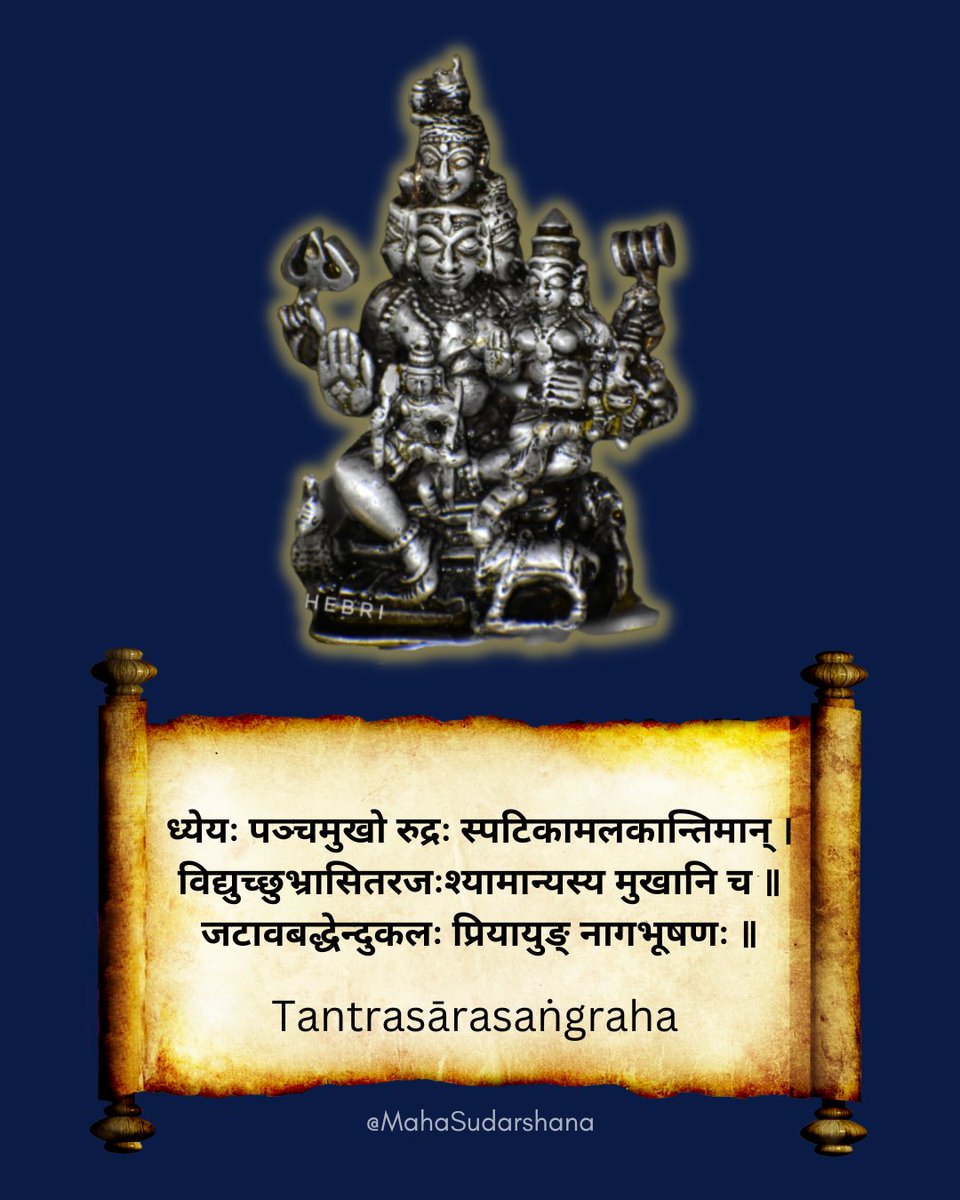
Worshipping the Vaiṣṇavottama:
The Vaiṣṇava Way
(based on the Pañcarātra)
[Kartika Somavara Vishesha]
ಕಾರ್ತೀಕ ಸೋಮವಾರದ ಪ್ರಯುಕ್ತ ಮಹಾರುದ್ರದೇವರ ಚಿಂತನೆ🙏🚩
(1)
#readthethread

The Vaiṣṇava Way
(based on the Pañcarātra)
[Kartika Somavara Vishesha]
ಕಾರ್ತೀಕ ಸೋಮವಾರದ ಪ್ರಯುಕ್ತ ಮಹಾರುದ್ರದೇವರ ಚಿಂತನೆ🙏🚩
(1)
#readthethread


Form of Lord Śiva:
Various descriptions of Lord Śiva varying in number of hands, his weapons, his complexion, etc., are found in several scriptural texts.
Śrīman Madhvācārya in Tantrasārasaṅgraha gives us a definitive form of Lord Śiva to meditate upon as propounded (2)

Various descriptions of Lord Śiva varying in number of hands, his weapons, his complexion, etc., are found in several scriptural texts.
Śrīman Madhvācārya in Tantrasārasaṅgraha gives us a definitive form of Lord Śiva to meditate upon as propounded (2)


by the Śiva pañcākṣara mantra,
"The 5-headed Rudra with the complexion of a clear quartz crystal, adorned with snakes as ornaments, whose faces are lightning-coloured, white, black, red and deep-blue respectively, is to be meditated upon along with his beloved (Pārvatī)." (3)

"The 5-headed Rudra with the complexion of a clear quartz crystal, adorned with snakes as ornaments, whose faces are lightning-coloured, white, black, red and deep-blue respectively, is to be meditated upon along with his beloved (Pārvatī)." (3)


Pratimā lakṣaṇa: iconography of Śiva, Padma Saṁhitā states: (Icon of) Śiva should be seated on a padma or siṁhāsana. On right and left sides, Gaṅgā and Yamunā, of fair and dark complexions resp., holding Cāmara (a fan made from horse's bushy-tail) should be installed. (4)
The Trilokeśvara vigraha at Kadri Mañjunātha temple is of this lakṣaṇa. The deity is 3-headed, 6-handed, and seated on Padmapīṭha; with Gaṅgā and Yamunā on either side. It's also the earliest bronze in South India (5) 

Various other pratimās like that of Nandi & others should also be installed as stated in scriptures.
Āvaraṇa devatās (peripheral deities) stated in Śaiva and Vaiṣṇava āgamas
are identical in the first āvaraṇa (layer) (6)
Āvaraṇa devatās (peripheral deities) stated in Śaiva and Vaiṣṇava āgamas
are identical in the first āvaraṇa (layer) (6)

but vary in the second one.
The second one is unique to the Vaiṣṇava āgama.
As these are all lesser deities, it is virtually impossible today to discern most of their forms for accurate depiction. (7)
The second one is unique to the Vaiṣṇava āgama.
As these are all lesser deities, it is virtually impossible today to discern most of their forms for accurate depiction. (7)
Upāsanā paddhati : Methodology of worship: Arghya, pādya, snāna, ācamanīya and vastra
should be offered with Tatpuruṣamantra; Upavīta, ābharaṇa with Īśānamantra; Gandha, puṣpa, dhūpa, dīpa, caru naivedya, mantrapuṣpa, and homa with Pañcākṣara mantra. (8)
should be offered with Tatpuruṣamantra; Upavīta, ābharaṇa with Īśānamantra; Gandha, puṣpa, dhūpa, dīpa, caru naivedya, mantrapuṣpa, and homa with Pañcākṣara mantra. (8)

About offering naivedya
Bhāradvāja Saṁhitā says—
प्रशस्तं भगवद्भुक्तं देवपितृसकर्मसु ।
Thus, all devatās including Lord Śiva, have to be offered the Viṣṇu naivedya only as their offering. (9)
Bhāradvāja Saṁhitā says—
प्रशस्तं भगवद्भुक्तं देवपितृसकर्मसु ।
Thus, all devatās including Lord Śiva, have to be offered the Viṣṇu naivedya only as their offering. (9)
Pādma-saṁhitā says,
विष्णोर्निवेदितान्नेन यष्टव्यं देवतांतरम् |
पितृभ्यश्चापि तद्देयं तदानंत्याय कल्प्यते ||
Offering Vishnu naivedya
to devatas and pitrus
gives akṣaya phala. (10)
विष्णोर्निवेदितान्नेन यष्टव्यं देवतांतरम् |
पितृभ्यश्चापि तद्देयं तदानंत्याय कल्प्यते ||
Offering Vishnu naivedya
to devatas and pitrus
gives akṣaya phala. (10)
Tāratamya and Antaryāmī cintana:
This is very important for proper upasana.
By citing sources such as Skanda purāṇa and Tattvasāra, Śrī Madhvācārya has established without doubt that the (In-dweller) and (Controller) of Śiva is none other than Saṅkarṣaṇa-nāmaka-Nṛsiṁha. 11

This is very important for proper upasana.
By citing sources such as Skanda purāṇa and Tattvasāra, Śrī Madhvācārya has established without doubt that the (In-dweller) and (Controller) of Śiva is none other than Saṅkarṣaṇa-nāmaka-Nṛsiṁha. 11


Prakāśa-saṁhitā says
संकर्षणो सहस्रास्यः फणिराट् बिंबरूपकः|
Saṅkarṣaṇa rūpa of Bhagavān
is the antaryāmī of Śeṣa
संकर्षणो नृसिंहेन अंतर्यामि शिवस्यतु |
Saṅkarṣaṇa by Nṛsiṁha rūpa is the Antaryāmī of Shiva.
Hence, the Antaryami in
Śiva for chintan is Narasimha. (12)
संकर्षणो सहस्रास्यः फणिराट् बिंबरूपकः|
Saṅkarṣaṇa rūpa of Bhagavān
is the antaryāmī of Śeṣa
संकर्षणो नृसिंहेन अंतर्यामि शिवस्यतु |
Saṅkarṣaṇa by Nṛsiṁha rūpa is the Antaryāmī of Shiva.
Hence, the Antaryami in
Śiva for chintan is Narasimha. (12)
Except Sriman Narayana and Mahalakshmi, all others, starting from Chaturmukha Brahma are jīva. Thus Lord Śiva is a jīva in the fifth kakṣā (After Viṣṇu, Lakṣmī, Ṛjus, and Ṛjvīs); the greatest Vaiṣṇava & leader of all devatās starting from Indra. (13)
He is also the controller of Manas (mind) and the regulator (abhimānī) of Ahaṁkāra-tattva (one of the 24 tattvas, not to be confused with Ego). Without surrendering to Lord Śiva, those of us can even hope for liberation. This is the Significance of
Mahādeva in Tattvavāda (14)
Mahādeva in Tattvavāda (14)
Lord Śiva in Mādhva literature:
Compositions such as Śiva Stuti of Nārāyaṇa Paṇditācārya, and Laghu Śiva Stuti of Vyāsatīrtha greatly extoll the virtues of Lord Śiva. Many compositions of Haridāsas also sing praise of Rudradeva. (15)
Compositions such as Śiva Stuti of Nārāyaṇa Paṇditācārya, and Laghu Śiva Stuti of Vyāsatīrtha greatly extoll the virtues of Lord Śiva. Many compositions of Haridāsas also sing praise of Rudradeva. (15)
Similarly, Lord Śiva is spoken highly of in other literary works of Mādhvas such as Tīrtha Prabandha of Vādiraja Tīrtha.
In this manner, the upāsanā of Lord Śiva as a parivāra devatā of Śrī Hari is not only recommended for Vaiṣṇavas, but also compulsory. (16)
In this manner, the upāsanā of Lord Śiva as a parivāra devatā of Śrī Hari is not only recommended for Vaiṣṇavas, but also compulsory. (16)
As the scriptures are too vast; we've barely even scratched the surface. This is merely an attempt to provide an overview of Śiva upāsanā as prescribed in the Śāstras for the benefit of sajjanas. (17)
॥ रुद्रान्तर्यामि-प्राणस्थ-श्रीलक्ष्मीनृसिंह प्रीयताम् ॥
॥ रुद्रान्तर्यामि-प्राणस्थ-श्रीलक्ष्मीनृसिंह प्रीयताम् ॥
• • •
Missing some Tweet in this thread? You can try to
force a refresh











